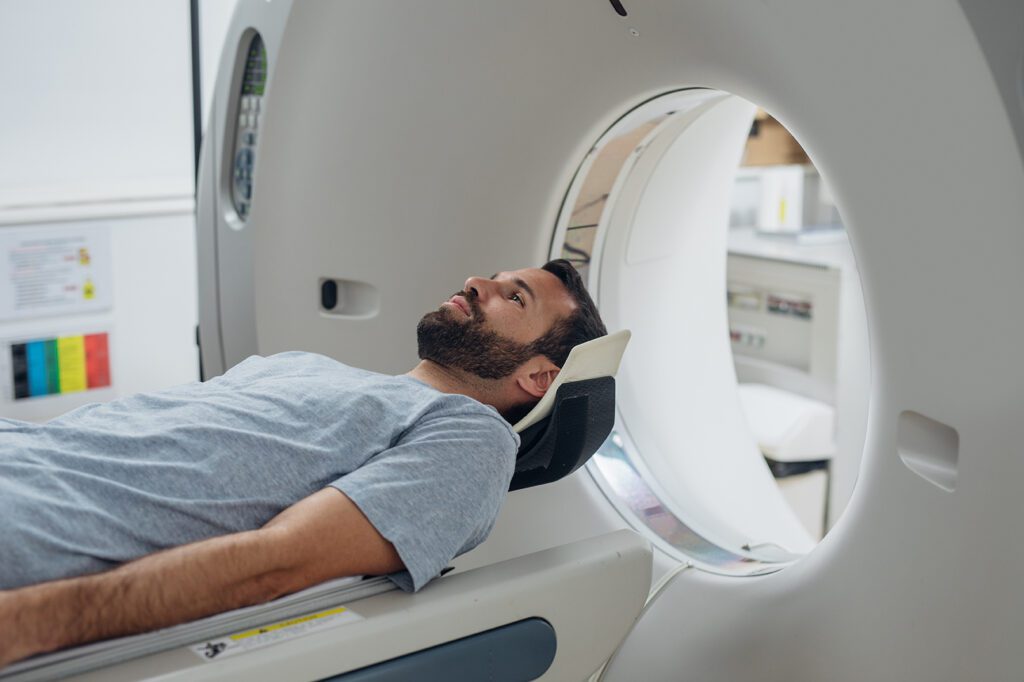Back pain can sometimes be absolutely excruciating. It can range from muscles that ache constantly to a shooting, burning, or stabbing sensation.
If you’re experiencing back pain, your healthcare provider may suggest that you have a lumbar-spine CT scan, which is a scan of your lower spine and the surrounding tissues.
A lumbar-spine CT is a great choice for people who are living with back pain. We’ll help you explore why your provider may have recommended a lumbar-spine CT scan.
When should I get a lumbar-spine CT scan for back pain?
If you are experiencing consistent back pain, your healthcare provider may recommend you get a lumbar-spine CT scan to see what is causing the pain.
There are five vertebrae of the lower back. The last vertebra attaches to the sacrum, and the top vertebra attaches to the thoracic section of the back.
An imaging scan of this area will help your healthcare provider diagnose the source and cause of the pain and develop the best treatment plan for you.
What symptoms show my healthcare provider that I need a lumbar-spine CT scan?
Symptoms such as severe lower back pain, weakness, or numbness in your legs, especially if you have a history of trauma to the spine, could indicate underlying issues like spinal fractures, herniated discs, or spinal stenosis. These conditions may require further evaluation through lumbar-spine CT imaging.
What specific conditions does a lumbar-spine CT scan best diagnose?
A lumbar-spine CT scan can assess your spine for a herniated disc, tumors, lesions, structural anomalies like spina bifida (a type of congenital defect of the spine), blood vessel malformations, or other conditions.
Lumbar-spine CT scans are particularly helpful when other types of examination, such as X-rays or a physical examination, are not conclusive. A lumbar-CT scan can also be used to evaluate the effects of treatment of the spine, such as surgery or other therapy.
How does a lumbar-spine CT scan help contribute to identifying the cause of back pain?
Lumbar-spine CT scans can provide more detailed information about the vertebrae (bones of the spine) and other spinal structures and soft tissues than standard X-rays of the spine, providing more information related to the spine’s condition.
What happens during a lumbar-spine CT scan
Before any imaging scan, it’s best to know what will happen during the scan. Knowing beforehand what will happen will help lessen your anxiety and stress. Here’s what happens during a lumbar-spine CT scan.
What does a lumbar-spine CT involve, and how long does it take?
During a lumbar-spine CT scan, the patient lies on a table that slides into the CT scanner.
The scanner takes a series of X-ray images from different angles, which are then processed by a computer to create cross-sectional images of the lumbar spine.
This helps in diagnosing conditions such as herniated discs, spinal stenosis, fractures, or tumors.
The procedure is painless, typically lasting about half an hour but no longer than an hour.
For some patients, before the scan, a contrast dye may be injected into a vein to enhance the images.
How should you prepare for a lumbar-spine CT scan?
Preparing for a lumbar-spine CT scan is similar to preparing for any other CT scan.
You will be asked to remove all piercings and any jewelry. Inform the radiologist of any metal implants you may have in your body.
Lumbar-spine CT scans are most frequently done with and without contrast dye. The contrast dye improves the radiologist’s ability to view the images of the inside of the body.
Your healthcare provider will advise you if you need to avoid certain foods or drinks before the scan.
Are there any risks or side effects associated with this scan?
Lumbar-spine CT scans are generally safe but there is a risk associated with exposure to low levels of radiation used during the scan. Also, if a contrast dye is used, some people have allergic reactions to the dye. Consult your healthcare provider if you have concerns about these risks.
Getting a CT scan when you have pain or mobility issues
All imaging scans come with some degree of anxiety, but having one performed while you are in pain or have difficulty moving can be an unpleasant experience.
Imaging centers understand these issues and make every accommodation possible to help the patient be as comfortable as possible during the scan.
If I have severe pain, or if I have mobility issues, can I still get a CT scan?
Yes, the imaging center and the technologist performing the scan will make special efforts to ease your pain during the scan.
Remember, your healthcare provider has reason to believe you need this scan to diagnose your back pain issues, so think of the scan as a tool that will help ease or cure your back pain.
What accommodations can an imaging center make for individuals with pain or trouble with mobility?
There will be designated parking spaces closer to the entrance for individuals with mobility difficulties.
The center should be wheelchair accessible, it should have a comfortable waiting area, and it may offer assistance upon arrival for those who need a little extra help.
Some imaging centers have modified imaging equipment to accommodate individuals with mobility limitations during imaging procedures. These centers can also offer sedation or relaxation techniques for individuals who may have difficulty lying still during imaging due to pain or discomfort.
What’s the best way to communicate my needs during the scan?
You will be able to communicate with your technologist at all times during the scan. You’ll be wearing headphones and will be able to talk to the technologist while you are in the imaging machine.

Your next steps after a lumbar-spine CT scan
Your lumbar-spine CT scan is now over and you have some questions, like, “what comes next?” and “how long will it take to get my results.” Let’s answer some of those questions.
How long will it take to get the results of my CT scan?
After the technician reads the scan, they will notify your healthcare provider, often within a couple of days. After that, your healthcare provider will reach out to you with the results.
If your provider sees anything concerning in your MRI results, they will contact you as soon as possible, likely not long after they examine your results.
How will my healthcare provider use my lumbar-spine CT results?
Your healthcare provider will use the results of your lumbar-spine CT scan to pinpoint the source of your back pain and develop the best plan for treatment for you.
When I talk to my provider about my CT scan results, what questions should I ask?
It is very important to be as frank as possible when you are meeting with your healthcare provider about the results of your lumbar-spine CT scan.
Here are a few useful questions to ask your healthcare team:
- What should I do next, based on these results?
- What are the potential long-term implications of these results?
- Should I consider seeing a specialist for further evaluation or treatment?
When you talk with your provider, make sure they use language that you can plainly understand, and don’t be afraid to ask them to explain things to you.
How to schedule your CT appointment with us
Touchstone Medical Imaging offers CT scans in Arkansas, Colorado, Florida, Montana, Oklahoma, and Texas.
Reach out to us at Touchstone, and we’ll help you schedule a CT Scan appointment at an imaging center near you, today.
We’re here to help you get the answers you need.
Frequently Asked Questions (FAQ)
Symptoms that may necessitate a lumbar-spine CT scan include persistent, severe pain, numbness, or weakness in your legs.
A lumbar-spine CT scan is particularly effective in diagnosing conditions such as herniated discs, spinal stenosis, and tumors.
It provides detailed images of both bone and soft tissues, helping pinpoint abnormalities or sources of pain.
The procedure involves lying on a table that slides into a CT scanner, typically taking about 30 minutes to complete.
Preparation may include avoiding certain foods or drinks and possibly wearing a hospital gown during the scan.
While generally safe, risks include exposure to low levels of radiation and potential reactions to contrast dye if used.
Yes, imaging centers can make accommodations for patients with severe pain or mobility issues to ensure their comfort during the scan.
Inquire about the findings, their implications for your condition, and the next steps in your treatment plan.


